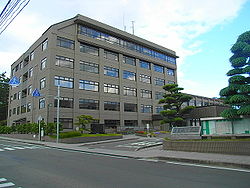Tagajō, Miyagi
|
Tagajō 多賀城市 |
|||
|---|---|---|---|
| City | |||

Tagajō City Hall
|
|||
|
|||
 Location of Tagajō in Miyagi Prefecture |
|||
| Coordinates: 38°17′39″N 141°0′16″E / 38.29417°N 141.00444°ECoordinates: 38°17′39″N 141°0′16″E / 38.29417°N 141.00444°E | |||
| Country | Japan | ||
| Region | Tōhoku | ||
| Prefecture | Miyagi | ||
| Government | |||
| • -Mayor | Kikuchi Kenjirou | ||
| Area | |||
| • Total | 19.65 km2 (7.59 sq mi) | ||
| Population (August 2014) | |||
| • Total | 62,329 | ||
| • Density | 3,170/km2 (8,200/sq mi) | ||
| Time zone | Japan Standard Time (UTC+9) | ||
| - Tree | Camellia sasanqua | ||
| - Flower | Iris sanguinea | ||
| Phone number | 022-368-1141 | ||
| Address | 1-1 Chūō 2-chōme, Tagajō-shi, Miyagi-ken 985-8531 | ||
| Website | Official website | ||
Tagajō (多賀城市 Tagajō-shi?) is a city located in Miyagi Prefecture, Japan. As of August 2014, the city had an estimated population of 62,329 and a population density of 3170 persons per km². The total area was 19.64 square kilometres (7.58 sq mi). The city was named after Taga Castle, the capital of Mutsu Province from the Nara period.
Tagajō is in east-central Miyagi Prefecture, bordered by the Pacific Ocean to the east.
The area of present-day Tagajō was part of ancient Mutsu Province, and has been settled since at least the Jomon period by the Emishi people. In 729 AD, during the Nara period, a large fortified settlement, Taga Castle, was established by the Yamato dynasty as a military center to establish control over the region and to protect colonists from western Japan. The fortification became the administrative capital of Mutsu province. The tsunami in 869 caused extensive flooding of the Sendai plain, destroying the town of Tagajō. Archaeological investigations have identified the remains of 8th and 9th century buildings beneath the present town, covered by sediments dated to the middle of the 10th century.
During the later portion of the Heian period, the area was ruled by the Northern Fujiwara. During the Sengoku period, the area was contested by various samurai clans before the area came under the control of the Date clan of Sendai Domain during the Edo period, under the Tokugawa shogunate. After the start of the Meiji period, the modern village of Tagajō was established with the creation of the municipalities system on April 1, 1889. From 1945 to 1954, a United States Army base, Camp Loper, was located in the town. Tagajō was elevated to town status on July 1, 1951. In the mid-1960s, the town was designated as an industrial development zone due to its proximity to Sendai harbor. Tagajō was designated a city on November 1, 1971. The city was seriously affected by the tsunami caused by the 2011 Tōhoku earthquake. As of April 7, 2011, 177 people were known dead, with 15 missing. 1,811 people were living in shelters.
...
Wikipedia



